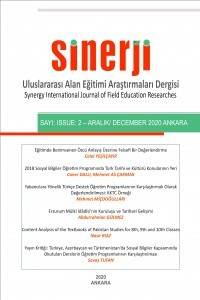8., 9. ve 10. Sınıf Pakistan Çalışmaları Ders Kitaplarının İçerik Analizi
Pakistan ortaya çıktığında coğrafi olarak Doğu ve Batı olmak üzere iki kanattan oluşan bölünmüş bir ülkeydi ve çeşitli etnik milliyetlerin bir karışımıydı. Etnik olarak çoğulcu bir devlet olan Pakistan, çok sayıda sorunla karşılaştı, ancak ulus inşa sürecine en büyük önceliği vermeye ikna oldu. Ancak, bağımsız bir Bangladeş devleti şeklinde ortaya çıkan doğu kanadı 1971'de kaybedilen, birleşik bir vatandaşlık yaratmaya yönelik tüm girişimler boşa çıktı. 1971'den sonra, Pakistanlılar arasında ulusal birliği ve vatanseverliği telkin etmeyi gerektiren çoğulculuktan kaynaklanan sorunlarla hala karşı karşıyadır. Bu ancak ulusal müfredatta değişiklik getirerek mümkün olabilir. Bu ulus inşası mücadelesinde eğitim sistemine ve özellikle Müfredat tasarımına gereken önem verilmektedir. Pakistan Çalışmaları, çeşitli dersler için kitapların içeriklerinin özel olarak tasarlandığı ve kontrol edildiği çeşitli konulardan biridir. Pakistan Çalışmalarını öğretmenin temel amacı, bir bireyin Pakistan'ın tarihi, coğrafyası, ekonomisi ve diğer devletlerle ilişkileri hakkındaki bilgilerini geliştirmektir. Bu analiz, Pakistan Araştırmaları ders kitaplarını 8., 9. ve 10. sınıflar için analiz etmeye özel önem vermektedir. Makalenin temel amacı, hedef kitapları içeriklerine göre tam olarak değerlendirmek, varsa eksiklikleri, ulus inşasında ne kadar yardımcı olduklarını belirlemek ve iyileştirme alanları önermektir.
Anahtar Kelimeler:
Pakistan, Pakistan Çalışmaları, Müfredat, Ulus İnşası ve Dini Azınlıklar
Content Analysis of the Textbooks of Pakistan Studies for 8th, 9th and 10th Classes
Pakistan, when came into existence, was geographically a divided country composed of two wings- East and West and was an amalgamation of various ethnic nationalities. Being ethnically a pluralist state, Pakistan faced a plethora of problems but was convinced to give top priority to nation-building process. However, all attempts at creating a unified citizenship ended in futile in 1971 when we lost our eastern wing which came out in the shape of an independent state of Bangladesh. After 1971 we still face the problems arising out of plurality which necessitates inculcating national unity and patriotism among Pakistanis. This can be possible only by bringing changes in national curriculum. The education system and specifically Syllabus designing is given due importance in this struggle for nation building. Pakistan Studies is one of the various subjects where the contents of the books for various classes are specially designed and controlled. The main objective of teaching Pakistan Studies is to promote the knowledge of an individual regarding the history, geography, economy of Pakistan and her relations with other states. An analysis of the contents of the subject shows that it tries to impart a manufactured patriotic sense of Pakistani citizenship and promotion of Islamic values. The present analysis gives special attention to analyze the textbooks of Pakistan Studies for 8th, 9th, and 10th classes. The main purpose of the paper is to fully evaluate the target books for their contents, pinpoint shortcomings, if any, how far they have been helpful in nation building and suggest areas for improvements.
Keywords:
Pakistan, Pakistan Studies, Syllabi, Nation Building Religious Minorities,
___
- Adeney, K. (2007). Federalism and ethnic conflict regulation in India and Pakistan. New York: Palgrave Macmillan.
- Ahmad, F. Javid, A. & Saeed, M. (2009). Pakistan Study, Grade 10th (Textbook) N.W.F.P. Textbook Board, Peshawar, Pakistan.
- Ahmed, A. S. (1997). Jinnah, Pakistan and Islamic identity: The search for Saladin. London & New York: Routledge.
- Amin, T. (1993). Ethno-national movements of Pakistan: Domestic and international factors. Islamabad: Institute of Political Studies.
- Ayres, A. (2009). Speaking like a state: Language and nationalism in Pakistan.Cambridge & New York: Cambridge University Press. Bakhtiar. (2006). Tareeh. Peshawar. KPK TextBook Board.
- Burki, S. J. (1986). Pakistan: A nation in the making. Boulder: Westview Press.
- Callard, K. (1957). Pakistan: A political study. London: George Allen and Unwin.
- Chowdhury, M. (1988). Pakistan: Its politics and bureaucracy. New Delhi: Associated Publishing House.
- Cohen, S. P. (2004). The idea of Pakistan. Washington D.C.: Brookings Institution Press.
- Jaffrelot, C. (2002). Nationalism without a nation: Pakistan searching for its identity. In C. Jaffrelot (Ed.), Pakistan: Nationalism without a nation? (7-48). New Delhi: Manohar Publishers.
- Jalal, A. (1985). The sole spokesman: Jinnah, the Muslim League and the demand for Pakistan. Cambridge: Cambridge University Press.
- Jalal. A. (1995). Democracy and authoritarianism in South Asia: A comparative and historical perspective. Cambridge: Cambridge University Press.
- Jinnah, M. A. (1962). Quaid-i-Azam Mahomed Ali Jinnah: Speeches as governor- general of Pakistan, 1947–48. Karachi: Pakistan Publications.
- Kapur, A. (1991). Pakistan in crisis. London & New York: Routledge.
- Khan, K. (2010). Alamzeb Umerzai and his political career until his martyrdom. Peshawar: Pakistan Study Centre.
- Malik, I. H. (2008). The history of Pakistan. London: Greenwood Press.
- Merchant, L. H. (1990). Jinnah: A judicial verdict. Karachi: East & West Publishing Company.
- Sayeed, K. B. (1996). Pakistan: The formative phase, 1857-1948 (2nd Edition).
- Karachi: Oxford University Press.
- Shah, S. R. A. (2006). Mutalia Pakistan. Peshawar. KPK TextBook Board.
- Shahid, S. M. (2007). The history of South Asia. Lahore: Munir Publications.
- Talbot, I. (1998). Pakistan: A modern history. London: Hurst and Company.
- Waseem, M. (1994). Politics and the state in Pakistan. Islamabad: National Institute of Historical and Cultural Research.
- Yayın Aralığı: Yılda 2 Sayı
- Başlangıç: 2020
- Yayıncı: Eğitim ve Bilim Politikaları Araştırma Derneği
Sayıdaki Diğer Makaleler
Erzurum Mülkî İdâdîsi’nin Kuruluşu ve Tarihsel Gelişimi
2018 Sosyal Bilgiler Öğretim Programında Türk Tarihi ve Kültürü Konularının Yeri
Caner DALLI, Prof. Dr. Mehmet Ali ÇAKMAK
8., 9. ve 10. Sınıf Pakistan Çalışmaları Ders Kitaplarının İçerik Analizi
Eğitimde Benimsenen Özcü Anlayış Üzerine Felsefi Bir Değerlendirme
